Fishing reel bearings are small metal balls that are used to reduce friction between moving parts. There are three types of fishing reel bearings: ball bearings, roller bearings, and thrust bearings.

What is Fishing Reel Bearings
Fishing reel bearings are small metal balls that are used to reduce friction between the spool and the line.
The bearings help the spool to rotate smoothly, which in turn helps the line to be cast more easily.
Types of Fishing Reel Bearings
There are three main types of fishing reel bearings: ball bearings, roller bearings, and thrust bearings. Each type has its own advantages and disadvantages.
Ball Bearing
Ball bearings are the most common type of fishing reel bearing. They are relatively inexpensive and easy to find.
They are made of a hard metal, such as steel, and they have a smooth surface.
Ball bearings have good rolling resistance, which makes them ideal for high-speed applications. However, ball bearings are not very durable and can be easily damaged by debris or corrosion.
Roller Bearing
Roller bearings are similar to ball bearings, but they have a cylindrical shape.
Roller bearings are more expensive than ball bearings, but they are much more durable.
Roller bearings have a higher load capacity than ball bearings and can withstand more abuse.
However, roller bearings are not as smooth as ball bearings and can be noisy in operation.
Thrust Bearing
Thrust bearings are the most expensive type of fishing reel bearing. Thrust bearings are designed to handle axial (thrust) loads only.
Fishing Reel Bearing Sizes
Fishing reel bearing sizes can be determined by the fishing line size and the drag setting.
The size of the fishing line will determine the maximum drag setting for a given reel.
For example, a 20-pound test line will have a maximum drag setting of 6 pounds. The higher the drag setting, the larger the bearings need to be.
The size of the fish you are trying to catch also determines the size of the reel bearings you need.
If you are fishing for smaller fish, then you can get away with smaller bearings. But if you are targeting larger fish, then you need to use larger bearings.
Finally, the type of fishing you are doing also dictates the size of reel bearings you need.
If you are just using your reel for light duty freshwater fishing, then small bearings will suffice.
Functions of Fishing Reel Bearings
Fishing reel bearings are small metal balls that are placed in a fishing reel to help the spool rotate smoothly.
The bearings help to reduce friction between the spool and the reel so that the line can be cast out more easily.
There are usually two types of bearings used in fishing reels, ball bearings and roller bearings. Ball bearings are the most common type of bearing used in fishing reels.
They are made up of two metal rings that have small balls in between them. The balls rotate freely between the rings and help to reduce friction.
Roller bearings are similar to ball bearings but they have cylindrical rollers instead of balls.
These rollers help to reduce friction even further and make for a smoother casting experience.
Essential Components of a Reel Bearing
There are four essential components of a reel bearing. They are:
Race
Merely rings of stainless steel that have been hammered, oxidized, and the set is units. On the inside and outside, each subdivision is at an extreme level.
Cage
Similar to a chain, they may be plastic or stainless steel. The rubber “rings” in which they are contained allow them to be evenly distributed and separated.
Balls
The forged metal wire is cut into many loops and melted using drawn steel machines. This process uses pressure instead of heat.
After that, the resulting balls are made smooth through a series of sequential processes and then hardened into shape with heat treatment.
Shield
Whenever the bearings need maintenance or lubrication, then it comes to action.
The shield may be permanent or detachable, and the latter makes cleaning or adding lubrication a little bit more complicated.
Material for Quality Ball Bearing
A ball bearing quality is determined by the quality of its components and the way it’s assembled; it also depends on the material type.
Lower-price models may comprise bearings made of chrome or chromium-plated steel, chromium steel, or other inferior materials.
The performance and lifespan of these bearings are not superior to that of “precision” stainless steel or ceramic ball bearings.
Stainless Steel
- Requires heat treatment to strengthen
- Relatively inexpensive
- Surface wear remains fine even after lubrication
- Life span is shorter than a ceramic ball
Ceramic
- Expensive than stainless steel
- Solid coating than stainless steel
- Better resistant to corrosion
- They are lighter than stainless steel
Fishing Reel Bearing Kits
Fishing reel bearing kits are important for anyone who wants to keep their fishing reel in good working order.
By replacing the bearings in your fishing reel, you can extend its life and keep it running smoothly.
Fishing reel bearing kits typically include all the bearings necessary to replace the ones in your reel, as well as any necessary washers or spacers.
Replacing the bearings in your fishing reel is a relatively easy process that anyone can do with a few simple tools.